The Survival of B. Subtilis Spores in Dicalcium Phosphate, Lactose, and Corn Starch and Their Binary Mixtures during Tableting
The survival of Bacillus subtilis spores in dicalcium phosphate, lactose, and corn starch and in their binary mixtures depends on the compressional properties of these materials and on parameters involved during the tableting process, including compression speed.
Microbial contamination of pharmaceutical raw materials may cause tablet spoilage, especially under humid conditions, and reportedly has led to infections in patients (1–3). Processes such as granule drying and tablet compaction can decrease the level of microbial contamination in tablet formulations (2). The extent of microbial destruction depends on the drying temperature, the compression pressure, the properties of the contaminating microorganisms, and the formulation's properties (3–6). Previous investigations have shown the destructive effect of binding agents used in wet granulation on Bacillus subtilis spores during tableting (6, 7). These studies established that log percent survival of B. subtilis spores is inversely related to compression pressure and concentration of the binder. This study examines the effect of compression speed on the level of microbial destruction during tableting.
Theoretical discussion
The increasing use of direct compression has increased the chances that substantial levels of microbial contamination may survive the initial stages of tablet manufacture. Because potential contamination of tablets may arise from heavy microbiological burden in raw materials, it is important to study the effect of the compression process on the survival of microorganisms in tablets (8).
The two main mechanisms of microbial kill during compression are localized heat and shearing force during compaction (5, 9). The shear stresses manifested during compression depend mostly on the main mode of consolidation of the formulation, which is achieved either by fragmentation or by plastic flow. Plastic flow is a highly effective mechanism for microbial kill even at low pressures (3). Therefore, the level of microbial destruction may depend on the compressional characteristics of the material because the amount of plastic deformation affects interparticulate bonding occurring during compression.
For this study, three materials—dicalcium phosphate (DCP), lactose, and corn starch, which are known to exhibit different compressional properties—and their binary mixtures were contaminated with B. subtilis spores and used to prepare tablets. The objective was to investigate the mechanism of microbial kill during tablet compression using the compression characteristics of the materials. Compression was performed at four compression speeds on a single-punch tableting machine and at a much slower speed on a hydraulic hand press.
The compressional characteristics of the materials were analyzed using the Heckel and Kawakita equations (10, 11). The Heckel equation relates the relative density, D, of a powder bed during compression to the applied pressure, P, and is written as:

The slope of the straight line, K, is the reciprocal of the mean yield pressure, Py , of the material. From the value of the intercept, A, the relative density, DA , can be calculated as (12):

The relative density of the powder at the point where the applied pressure equals zero, D0 , is used to describe the initial rearrangement phase of densification as a result of die filling. The relative density DB describes the rearrangement phase at low pressures and is the difference between DA and D0 :

The Kawakita equation is used to study powder compression using the degree of volume reduction C and is written as:

The equation can be rearranged as:

in which V0 is the initial bulk volume of the powder, and Vp is the bulk volume after compression. The constant a is equal to the minimum porosity of the material before compression, and the constant b is related to the plasticity of the material. The reciprocal of b gives a pressure term Pk , which is the pressure required to reduce the powder bed by 50% (13, 14).
Materials and methods
Materials. The materials used in this study were dicalcium phosphate (DCP, mean particle size = 96.50 μm) obtained from SAM Pharmaceutical Ltd. (Ilorin, Nigeria); lactose BP (mean particle size = 76.50 μm) also obtained from SAM Pharmaceutical; corn starch BP (mean particle size = 14.80 μm) obtained from BDH Chemicals Ltd. (Poole, UK); and magnesium stearate also obtained from BDH Chemicals. All materials were of pharmaceutical grade.
Preparation and characterization of powders. Binary mixtures were prepared by mixing the materials in the right proportions thoroughly in a bottle. Particle densities of the individual powders and the binary mixtures were determined using the pycnometer method with xylene as the displacement fluid (16). Bulk densities of the single materials and the binary mixtures were determined by pouring each powder at an angle of 45° through a funnel into a glass measuring cylinder, which had a diameter of 21 mm and a volume of 50 mL (15, 16). Determinations were done in triplicate. The relative density, D0 , of each powder was obtained from the ratio of its loose density to its particle density.
Preparation of inoculum. B. subtilis, a spore-forming bacterium, was chosen as the contaminating microorganism because of its resistance to destruction by physical and chemical agents. An 18-h overnight culture was prepared from B. subtilis (laboratory stock culture, Department of Veterinary Microbiology and Parasitology, University of Ibadan) in single-strength sterile nutrient broth. One milliliter of the overnight culture was placed in 9 mL of sterile distilled water. From this, 2-mL samples were drawn and placed in sterile glass mortars, covered, and allowed to dry at 37 °C for 48 h.
Contamination of powders. Ten grams each of the powder materials and their binary mixtures were gently mixed in the contaminated glass mortar by method of increasing quantities (4, 6). Viable counts of microbial contaminants were carried out on the contaminated and uncontaminated materials.
Preparation of tablets. Contaminated and uncontaminated materials in 500 ± 10-mg quantities were compressed for 1 min under predetermined pressures using a hydraulic hand press (model C, Carver Inc., Menomonee Falls, WI) fitted with a pressure gauge reading as high as 2.5 metric tons. The 10.5-mm diameter die and the flat-faced punches were lubricated with a 2% w/v dispersion of magnesium stearate in ethanol before each compression. After ejection, the tablets were stored over silica gel for 24 h to allow for elastic recovery and hardening. Their weights, w, and dimensions were determined to within ±1 mg and 0.01 mm, respectively, and their relative densities, D, were calculated according to the equation:

in which Vt is the volume (cm3 ) of the tablet and ρs is the particle density (g/cm3 ) of the solid material. Heckel plots of ln(1 ÷ [1 – D]) versus applied pressure P and Kawakita plots of (P ÷ C) versusP were constructed for all materials.
We also prepared 500-mg tablets of all materials using a single-punch tableting machine (Erweka AR400, Erweka, Heusentamm, Germany) at various pressures using 10-mm flat-faced punches at compression speeds of 20, 40, 80, and 120 mm/s. The punches and die were lubricated with a 2% w/v dispersion of magnesium stearate in ethanol before each compression.
Determination of viability. Contaminated or uncontaminated tablets in 1-g quantities were disintegrated in 9 mL of distilled water. Serial dilutions were made and viability assessed using the pour-plate method. The plates were incubated at 37 °C for 24 h. Survival, estimated as the mean of quadruplicate determinations, was expressed for the contaminated formulations as a percentage relative to uncompressed control contaminated material.
Statistical analysis. Statistical analysis to compare the survival of B. subtilis spores in the tablets was carried out using analysis of variance (ANOVA) and computer software (GraphPad Prism 4, GraphPad Software Inc., San Diego, CA). Tukey-Kramers multiple comparison tests were used to compare the individual differences between tablets prepared using the two tablet presses and at different compression speeds on the single punch machine. At 95% confidence interval, p values ≤0.05 were considered significant.
Results and discussion
Compression properties. Figure 1 shows representative Heckel plots for the single materials and their binary mixtures (40:60 ratio) prepared on the hydraulic press. The Heckel plots for DCP and lactose showed an initial curve followed by a linear region with correlation coefficient of ≥0.980. The initial curve suggests that fragmentation and particle rearrangement were occurring during the initial stages of compression. Lactose is a brittle crystalline material and tends to consolidate by brittle fracture during the early stages of compression and by plastic flow during later stages (17, 18). DCP consolidates almost entirely by fragmentation (19, 20). In contrast, corn starch deforms mainly by plastic flow (15), which is evidenced by the absence of an initial curve in its Heckel plot. Changing the concentrations of the materials in the binary mixtures altered the mode of consolidation of the mixtures.

Figure 1. Heckel plots for single materials and their 40:60 binary mixtures on a Carver hydraulic press.
Figure 2 shows representative Kawakita plots for the single-materials and their binary mixtures (40:60) prepared on the hydraulic press. All plots were linear with a correlation coefficient of 0.999 for the single materials and their binary mixtures.

Figure 2. Kawakita plots for single materials and their 40:60 binary mixtures on a Carver hydraulic press.
The parameters derived from density measurements and the Heckel and Kawakita plots for the single materials and their binary mixtures prepared using the hydraulic press and the single-punch machine are presented in Tables I and II, respectively. For single materials, the general ranking of D0 values was lactose > corn starch > DCP. The ranking for DI = 1 – a, which is the packed initial relative density of the material with the application of small pressure (or what may be referred to as tapping), was corn starch > lactose > DCP (21). The ranking of DA was lactose > DCP > corn starch, and the ranking for DB was DCP > lactose > corn starch. The values of DA and DB for materials compressed on the single-punch machines generally were lower than those values for materials compressed on the hydraulic press. Moreover, the values of DA, DB , and DI for materials compressed with the single-punch machine generally decreased with as compression speed increased.
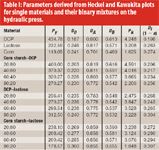
Table I: Parameters derived from Heckel and Kawakita plots for single materials and their binary mixtures on the hydraulic press.
The ranking of D0 and DI for the binary mixtures was corn starch–lactose > DCP–lactose > corn starch–DCP. The ranking for DA was corn starch–lactose > corn starch–DCP > DCP–lactose. The ranking for DB was corn starch–DCP > corn starch–lactose > DCP–lactose. The values of DA and DB decreased as the proportion of corn starch in the relevant binary mixtures increased. For the DCP–lactose mixtures, the values of the two parameters decreased as the concentration of DCP increased. Furthermore, the values of the parameters generally were lower for materials compressed on the single-punch machine than for materials compressed on the hydraulic press.
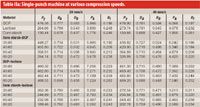
Table IIa: Single-punch machine at various compression speeds.
The ranking of Pk and Py for the single materials was generally DCP > lactose > corn starch (see Tables I and II). Both Py and Pk are inverse measures of plasticity. Corn starch, which had the lowest Pk values, also showed the lowest Py values. Odeku and Itiola (21) showed that although Py relates essentially to the onset of plastic deformation, Pk relates to the amount of plastic deformation occurring during compression. Thus, corn starch, which had the fastest onset of plastic deformation, exhibited the highest total amount of plastic deformation, and DCP had the lowest values of both measures. The differences between the single materials for the two parameters were significant (p <0.01).

Table IIb: Single-punch machine at various compression speeds.
The Pk and Py values for materials compressed on the single-punch machine are presented in Table II. The Pk and Py values for these materials were higher than those for materials compressed on the hydraulic press (see Table I), which indicates that more plastic deformation occurred for materials compressed on the hydraulic press under a longer dwell time. The differences were generally not significant (p >0.05), however. Furthermore, the Pk and Py values for the materials compressed on the single-punch machine generally decreased as compression speed increased. This result should be expected because plastic deformation is a time-dependent process (18) and tends to increase with dwell time. The influence of compression speed in this study also was not generally significant (p >0.05).
The ranking of Pk and Py for the binary mixtures was corn starch–DCP > DCP–lactose > lactose–corn starch. Thus, the values of Pk and Py generally were higher for mixtures containing DCP. The rather poorly compressible DCP having a markedly higher Py value seemed to have had great influence on the compressibility of the powder mixtures. The fracturing of brittle particles is dependent mainly on the applied stress and may be considered an on–off event (22). Thus, when the elastic limit is exceeded, fracture occurs, whereas if the stress is too low, then the structure remains intact. A separate study suggested that the less deformable particles in the mixtures make up a continuous network or a skeleton, which tends to prevent fracturing of the more readily deformable particles (20). This result appears to be the case in the present study.
Microbial survival during tableting. The test on uncontaminated powders showed no growth or negligible growth of less than 102 cfu/g of spores. No growth was obtained from any of the powder mixtures after the uncontaminated powders were compressed, even at the lowest compression pressure (28.31 MPa). Thus, the survival of the organisms after compression seems to be mainly from the deliberate contamination of the materials.
Plots of the log percent survival of B. subtilis spores in the contaminated materials versus the compression pressure for corn starch compressed at various speeds on the single-punch machine reveal that the log percent survival was inversely proportional to compression pressure (see Figure 3). This was the case for all materials compressed on both presses. The relationship was linear with correlation coefficient of r = –0.985 to –0.991, –0.967 to –0.986, and –0.949 to –0.989 for corn starch, lactose, and DCP, respectively. The values of r = –0.936 to 0.990, –0.957 to –0.975, and –0.909 to –0.980 for corn starch–DCP, corn starch–lactose, and DCP–lactose binary mixtures, respectively. These correlations were significant (p < 0.01 in each case) according to the ANOVA analysis. Other studies have confirmed the inverse linear relationship for other pharmaceutical materials (3, 6).

Figure 3. Log % survival versus compression pressure (MPa) for corn starch at various compression speeds on a single punch machine
Materials compressed on the hydraulic press at the highest compression pressure of 226.46 MPa had a reduced viability of B. subtilis spores. Tablets prepared with corn starch showed a 90% reduction, those made with lactose had an 85% reduction, and those made with DCP had an 81% reduction. Tablets made from binary mixtures also had reduced viability of B. subtilis spores: a 82% reduction for tablets made with corn starch–lactose; a 77% reduction for tablets made with corn starch–DCP; and 75% reduction tablets made with DCP–lactose.
Similarly, tablets prepared on the single-punch machine at the highest compression pressure of 224.46 MPa had reduced viability of B. subtilis spores. Tablets prepared from corn starch had a 50% reduction, those prepared from lactose had a 37% reduction, and those prepared from DCP had a 35% reduction. Reductions in viability of B. subtilis spores also were observed in tablets made from the binary mixtures: 40% reduction for tablets made with corn starch–lactose tablets, a 34% reduction for tablets made with corn starch–DCP tablets, and a 30% reduction for tablets made with DCP–lactose.
The results indicate that the plastically deforming corn starch exhibited the highest reductions in the viability of B. subtilis spores, and DCP exhibited the lowest. Corn starch undergoes plastic deformation, which can cause localized shear flow and which under compression pressure would lead to greater interparticulate contact, thereby enhancing the mechanical disruption of microorganisms (3). On the other hand, materials such as lactose and DCP, which tend to undergo fragmentation and brittle fracture, can rearrange and fill the available void spaces, thus increasing the area of interparticulate contact on fracturing. In this case, the microorganisms would be inactivated by shearing. Results obtained in this study suggest that the compression of plastically deforming materials causes more bacterial inactivation than do the fracturing materials. A supportive mechanism involved in the destruction of microorganisms is the heat generated by friction during tableting, which should be higher for the plastically deforming corn starch than for the other two materials.
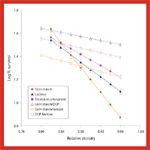
Figure 4. Log % survival versus relative density for single materials. and their 40:60 binary mixtures on a Carver hydraulic press.
Manufactured tablets usually are presented in terms of their relative density. The authors constructed representative plots of log percent survival of B. subtilis spores in the contaminated materials versus relative density for the single materials and their binary mixtures (40:60) compressed on the hydraulic press (see Figure 4) as well as three-dimensional plots of log percent survival versus relative density for contaminated corn starch compressed at different speeds on the single-punch machine (see Figure 5). For all materials compressed on both presses, results showed an inverse relationship between the log percent survival of B. subtilis spores and the relative density. Correlation coefficients for linearity, r, were –0.960 to –0.995, –0.946 to –0.987, and –0.964 to –0.992, for corn starch, lactose, and DCP, respectively; and –0.989 to –0.994, –0.918 to –0.975, and –0.961 to –0.994 for corn starch–DCP, corn starch–lactose, and DCP–lactose binary mixtures, respectively. These correlations were significant (p < 0.001) in each case, according to ANOVA analysis.
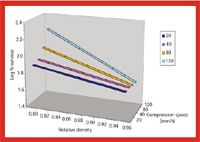
Figure 5. 3-D plots of log % survival versus relative density for corn starch at various compression speeds on a single-punch machine.
Table III shows the survival of B. subtilis spores in the materials at a relative density of 0.90, which is representative of the relative density for commercial tablets, for materials compressed on both types of tablet machines. These results were analyzed using the Tukey–Kramer multiple comparison test (GraphPad Prism, GraphPad Software Inc., San Diego, CA). The survival of the microorganisms was significantly lower (p <0.01) for materials compressed on the hydraulic press than those compressed on the single-punch press. Furthermore, the survival of the organisms in tablets prepared using the single-punch machine was affected by the compression speed, with survival generally increasing as compression speed increased. There was no statistically significant difference (p >0.05) in the survival of the organisms using different compression speeds, however.
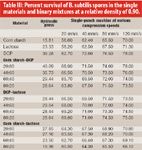
Table III: Percent survival of B. subtilis spores in the single materials and binary mixtures at a relative density of 0.90.
The ranking of survival in tablets made with single materials was corn starch < lactose < DCP (see Table III). Results showed a statistically significant difference (p <0.05) between the survival in DCP tablets and those made with the two other materials compressed on the hydraulic press, but there was no statistically significant difference (p >0.05) for survival in the three materials on the single-punch press at various compression speeds.
For tablets made with the binary mixtures, corn starch–lactose mixtures showed the lowest survival of B. subtilis spores. For all mixtures containing corn starch, survival of the organisms decreased as the proportion of corn starch in the mixture increased, thereby showing the relevance of plastic deformation in the destruction of microorganisms. In DCP–lactose mixtures, however, the pattern of survival was less conclusive. This result suggests that the two powders, which tend to deform to a large extent by brittle fracture and fragmentation, did not modify their respective deformation properties materially. There was generally no statistically significant difference (p >0.05) in the survival of the organisms for the various proportions of the materials.
These results show that tablets containing corn starch, which has the highest degree of plastic deformation as evidenced by low Py and Pk values, had the highest level of microbial kill during tablet compression. Thus, corn starch would exhibit greater surface disruption and would destroy more organisms that are bonded to or in powders than brittle materials (3). It is also notable that binary mixtures containing DCP exhibited the lowest reductions in the viability of B. subtilis. This supports the suggestion that poorly compressible, brittle DCP reduces the plastic deformation of the mixtures. In addition, binary mixtures containing DCP had the highest Py and Pk values, which implies poor plastic flow. Therefore, the compressional characteristics of the materials as described by the parameters obtained from the Heckel and Kawakita plots may provide some indication of the likelihood of survival of microorganisms in pharmaceutical materials during tableting.
In practice, tableting speeds are significantly increased during drug production scale-up and technology transfer. Thus, the results of this study suggest that microorganisms in raw materials might exhibit significant level of survival on tablet production presses, which tend to operate at very high speeds, usually in excess of 200 mm/s. Expectations of microbial destruction during direct compression tablet production cannot be taken as a guarantee that any microbial contamination of raw materials will be eliminated during tableting. Therefore, manufacturers must implement microbial control on their tablet ingredients for direct compression by ensuring approval and validation of the active and excipient raw materials in the pilot plant, and raw materials must meet microbial specifications consistently.
Conclusion
This study shows that the survival of B. subtilis spores can be reduced considerably during tableting and is dependent on the type of material and its compression properties. The survival depends on the type of tablet press used and increases as compression speed increases. Results suggest that values of Py and Pk derived from the Heckel and Kawakita equations, respectively, can provide some insight into the level of microbial survival in the materials after tableting. Nonetheless, expectations of microbial destruction during tableting is no substitute for stringent control of microbial levels in the raw materials for direct compression on high-speed tablet presses in practice.
J.O. Ayorinde is a research student, O.A. Odeku, PhD,* is a senior lecturer, and O.A. Itiola, PhD, is a professor, all at the Department of Pharmaceutics and Industrial Pharmacy, Faculty of Pharmacy, University of Ibadan, Ibadan, Nigeria, tel. 1234 8033 235828 or 1234 2810 6403, pejuodeku@yahoo.com
*To whom all correspondence should be addressed
References
1. A. Fischer, B. Fuglseng-Smith, and K. Ulrich, "Microbial Content of Nonsterile Pharmaceuticals IV: Tablets," Dansk. Tisskr. Farm. 42, 125–131 (1968).
2. C.E. Bos, H. Van Doorne, and C.F. Lerk, "Microbiological Stability of Tablets Stored under Tropical Conditions," Int. J. Pharm. 55 (2–3), 175–183 (1989).
3. T.C. Blair, G. Buckton, and S. Bloomfield, "On the Mechanism of Kill of Microbial Contaminants during Tablet Compression," Int J. Pharm. 7, (3), 111–115 (1991).
4. E.J. Plumpton, P. Gilbert, and J.T. Fell. "Effect of Spatial Distribution of Contaminating Microorganisms within Tablet Formulation on Subsequent Inactivation through Compaction," Int. J. Pharm. 30 (2–3), 237–240 (1986).
5. E.J. Plumpton, P. Gilbert, and J.T. Fell. "The Survival of Microorganism during Tableting," Int. J. Pharm. 30, 240–246 (1986).
6. O.A. Odeku, O.A. Itiola, and H.A Odelola, "Evaluation of the Destructive Effect of Khaya Gum on B. subtilis Spores during Tableting," Phytother. Res. 13, 296–299 (1999).
7. O.A. Odeku and O.A. Itiola, "Characterisation of Khaya Gum as a Binder in a Paracetamol Tablet Formulation," Drug Dev. Ind. Pharm. 28 (3), 329–337 (2002).
8. K.H. Wallhauser, "Microbiological Aspects on the Subject of Oral Dosage Forms," Pharm. Ind. 39, 491–497 (1977).
9. A.R. Fassihi and M.S. Parker, "The Effects of Processing Factors upon the Microbial Content of Tablets," J. Appl. Bacteriol. 43, xvii (1977).
10. R.W. Heckel, "Density–Pressure Relationships in Powder Compaction," Trans. Metall. Soc. A.I.M.E 221, 671–675 (1961).
11. K. Kawakita and K.H. Ludde, "Some Considerations on Powder Compression Equations," Powder Technol. 4 (2) 61–68 (1970).
12. P. Humbert–Droz, D. Mordier, and E. Doelker, "Densification Behaviour of Powder Mixtures," Acta Pharm. Technol. 29, 69–73 (1983).
13. P. Shivanand and O.L. Sprockel, "Compaction Behaviour of Cellulose Polymers," Powder Technol. 69 (1), 177–184 (1992).
14. C. Lin and T. Cham, "Compression Behaviour and Tensile Strength of Heat-Treated Polyethylene Glycols," Int. J. Pharm. 118 (2), 169–179 (1995).
15. P. Paronen and M. Juslin, "Compressional Characteristics of Four Starches," J. Pharm. Pharmacol. 35, 627–635 (1983).
16. O.A. Itiola, "Compressional Characteristics of Three Starches and the Mechanical Properties of their Tablets," Pharm. World J. 8 (3), 91–94 (1991).
17. J.A. Hersey and J.E. Rees. "Deformation of Particles during Briquetting," Nature 230, 96 (1971).
18. N.A. Armstrong and L.P. Palfery, "The Effect of Machine Speed on the Consolidation of Four Directly Compressible Diluents," J. Pharm. Pharmacol. 41, 149–151 (1989).
19. M. Duberg and C. Nystrom, "Studies on Direct Compression Tablets 6: Evaluation of Methods for the Estimation of Particle Fragmentation during Compaction," Acta Pharm. Suec. 19, 421–426 (1982).
20. J. Ilkka and P. Paronen, "Prediction of the Compression Behaviour of Powder Mixtures by the Heckel Equation," Int. J. Pharm. 94, (1–3), 181–187 (1993).
21. O.A. Odeku and O.A. Itiola, "Evaluation of Khaya Gum as a Binder in a Paracetamol Tablet Formulation," Pharm. Pharmacol. Commun. 4, 183–188 (1998).
22. E.T. Cole, J.E. Rees, and J.A. Hersey, "Relations between Compaction Data for Some Crystalline Pharmaceutical Materials," Pharm. Acta Helv. 50, 28–32 (1975).

Drug Solutions Podcast: A Closer Look at mRNA in Oncology and Vaccines
April 30th 2024In this episode fo the Drug Solutions Podcast, etherna’s vice-president of Technology and Innovation, Stefaan De Koker, discusses the merits and challenges of using mRNA as the foundation for therapeutics in oncology as well as for vaccines.




















